Electric guitars are distinctive in their tone and music compatibility. Since its 1931 debut, electric guitars have shaped rock and roll, blues, and heavy metal. New features have made them smarter and more useful over time.
This post will cover types of electric guitars and how their inventiveness and versatility have kept them popular for decades.
The Anatomy of Electric Guitars: Exploring Parts and Mechanisms
When looking for an electric guitar that fits your needs, the most important things you can learn are about the brands and how they look. These considerations are common things, but let’s remember why those brands are famous in the first place: they do a great job of packing great features altogether in a guitar.
An electric guitar can be categorized by many ways. Which one they get depends on their body form, bridge type, and other factors. It’s the parts and how they work that matters. We can choose or switch guitars to suit our tastes if we know what each part does.
Let’s take a closer look at the individual parts on electric guitars and materials that go into making an electric guitar, from start to finish.
Body Types
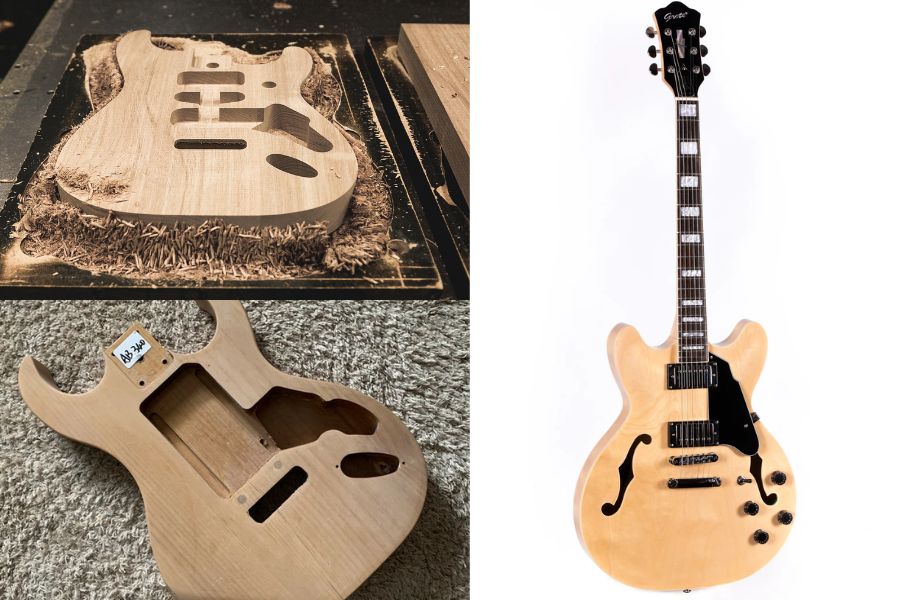
Solid Body
Most electric guitars are solid-body guitars, which are known for being durable, not giving in to feedback, and having a lot of different tones. The solid mass gives the mics a stable place to sit, which lets them make a clear, long-lasting sound that can be used in a variety of styles.
Due to their solid wood structure, solid-body guitars are denser and heavier than hollow-body guitars, which contain resonant chambers. In rock, metal, and other styles where loudness and clear sound are important, solid-body guitars are the best choice.
Semi-Hollow Body
Semi-hollow guitars have a solid block in the middle of a hollow body. This style blends the warmth and resonance of hollow-body guitars with the sustain and feedback resistance of solid bodies. This makes them very useful for a wide range of situations.
They’re popular in rock, blues, jazz, and indie music, among others.
Hollow Body
Just like acoustic guitars, hollow-body guitars are hollow on the inside. This gives them a rich, resonant tone that is softer and more natural than solid bodies. This can be a problem or a feature that is used to your advantage based on the genre. They often give off feedback when played loudly or with a lot of gain.
They have a deep sound that makes jazz, blues, and country musicians like them.
Wood Types
Each type of wood has its own qualities that affect how a guitar looks, sounds, and is played. This is why different woods are paired with different guitar bodies.
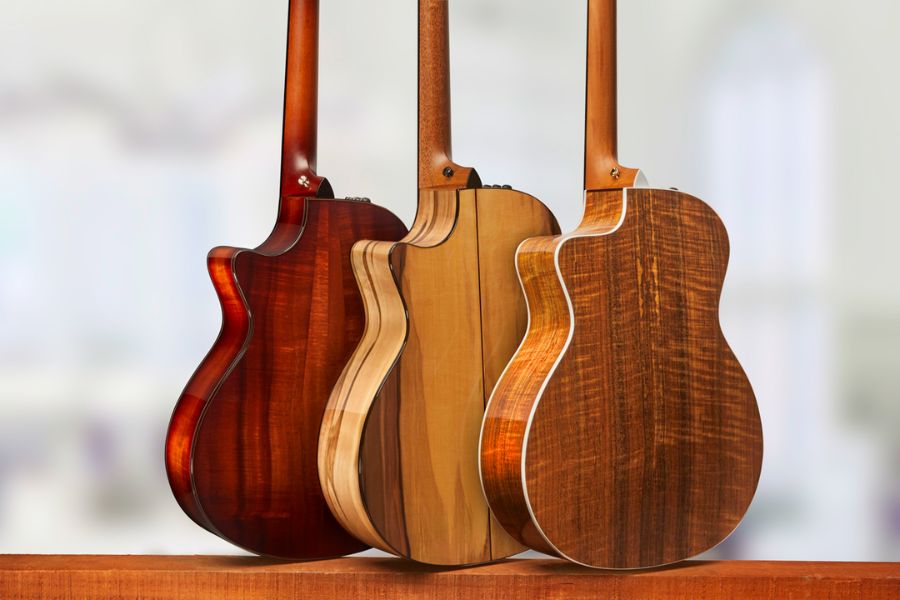
Solid Body Guitars
Alder: Alder is truly a favored wood for solid-body guitars due to its balanced low, mid, and high frequencies. Its nature is lightweight yet robust.
Mahogany: Mahogany, on the other hand, has a warmer, fuller tone with a highlight on low-end and midrange frequencies. Because it is heavier than alder, it will sustain notes for longer.
Semi-Hollow Body Guitars
Mahogany with Maple Top: For semi-hollow guitars, I love the combination of mahogany with a maple top. The mahogany’s warmth paired with the brightness of maple is cool. Everyone wants this mix, whether they like jazz, blues, or rock.
Ash: Bright, resonant, and sustains. For semi-hollow bodies used in a wide range of styles, ash is a great choice because it has an open grain and a clear sound.
Hollow Body Guitars
Maple: Its bright, crisp tone cuts through mixes, especially in jazz ensembles. Maple hollow bodies are perfect for genres that need subtle articulation because of their projection and clarity.
Spruce: Acoustic and hollow body guitars often have spruce tops for their rich timbre. They are ideal for jazz and folk music that requires volume and clarity because to their wide dynamic range and robust tone.
Cutaway Design
An electric guitar’s cutaway, double cutaway, or no cut at all affects its appearance and utility. Specifically, these tweaks improve upper fret access.
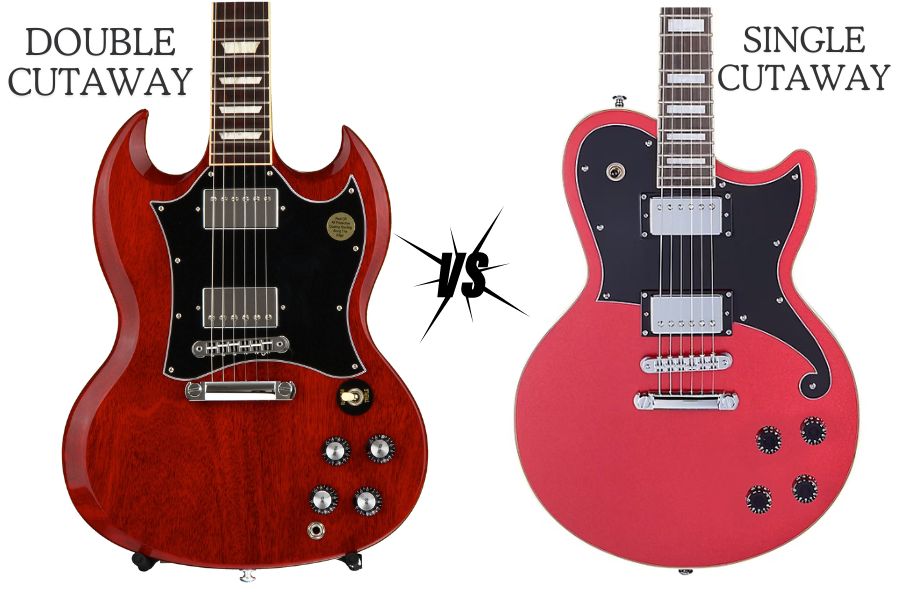
Single Cutaway
A guitar body with a single cutaway, like the Gibson Les Paul or the Fender Telecaster, makes it easier to reach the higher notes than a body without a cutaway. People who play guitar can play higher notes more easily with this feature, which is great for solos and lead guitar work.
The single cutaway design retains greater guitar body mass, which may give it a richer, fuller tone due to the bigger resonating surface.
Double Cutaway
Double cutaways on guitars like the Fender Stratocaster and Gibson SG make it even easier to get to the higher frets from both sides of the neck. Guitarists that play high notes enjoy these designs because they make reaching the top frets simple.
As a result of their ergonomic benefits, double cutaways are very common, even though they might reduce the body’s mass compared to single cutaways.
Pickup Configuration
Pickups are key to finding your sound. Whether you want something bright and clear or warm and full, there’s a pickup for you.
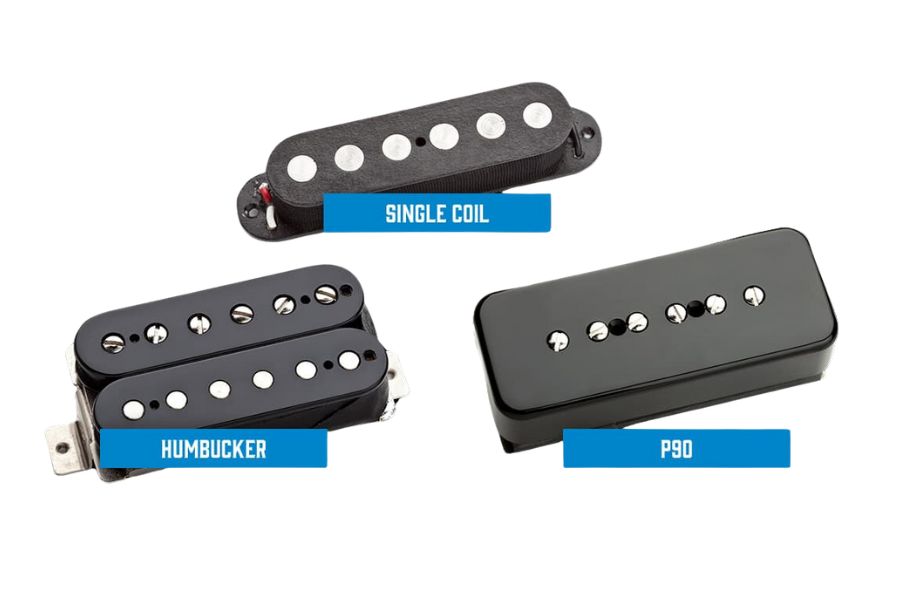
Single-Coil
Single-Coil pickups are bright and clear. They’re perfect for blues, country, and surf music. But they might hum when it gets loud or around electronic stuff.
Humbucker
Humbucker pickups put two single-coils together to stop the hum. They give you a warm, full sound that’s great for rock, metal, and jazz.
P90
P90 pickups are in the middle. They’re a bit raw and gritty. You get warmth but also some brightness. They rock in punk, rock, and blues.
Pickup configuration really changes how a guitar sounds. You’ve got options like HSS, SSS, and HH. And whether pickups are active or passive also affects your sound. Active ones are great for a strong, even sound at high volumes.
Bridge Types
The type of bridge (e.g., tremolo/vibrato systems, fixed bridges, Tune-O-Matic, floating bridges) affects not just tuning stability and sustain, but also the player’s ability to use vibrato and bending techniques. Each bridge type offers a unique balance of functionality and tonal characteristics.
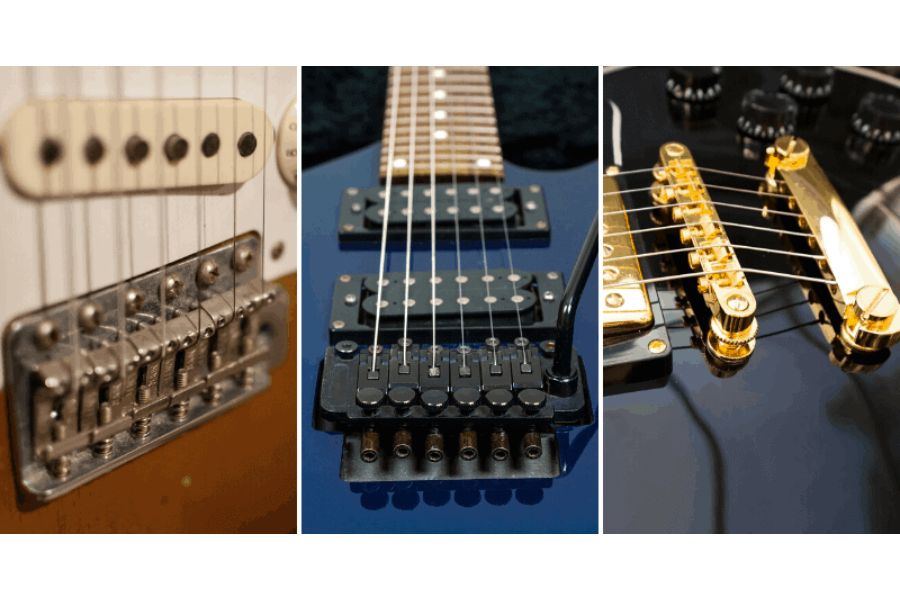
Tremolo/Vibrato Bridges
These let you change the pitch to get cool vibrato effects. Great for styles like surf rock and metal. The bad new is that your guitar might get out of tune more often if you use them.
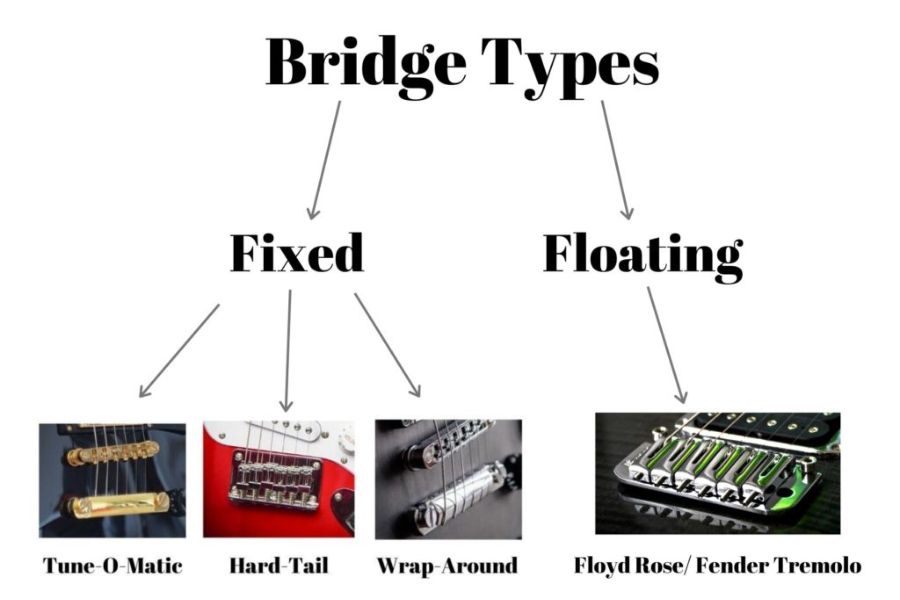
Fixed Bridges
These are all about keeping your guitar in tune and making the notes last longer. The strings are very simple to change and take care of. Great for keeping the same pitch, especially when playing beat or styles that need you to do that all the time.
Neck Construction
It matters a lot what shape the neck is and how it’s connected to the body. They change how the electric guitar sounds, how long notes last, and how simple it is to fix.
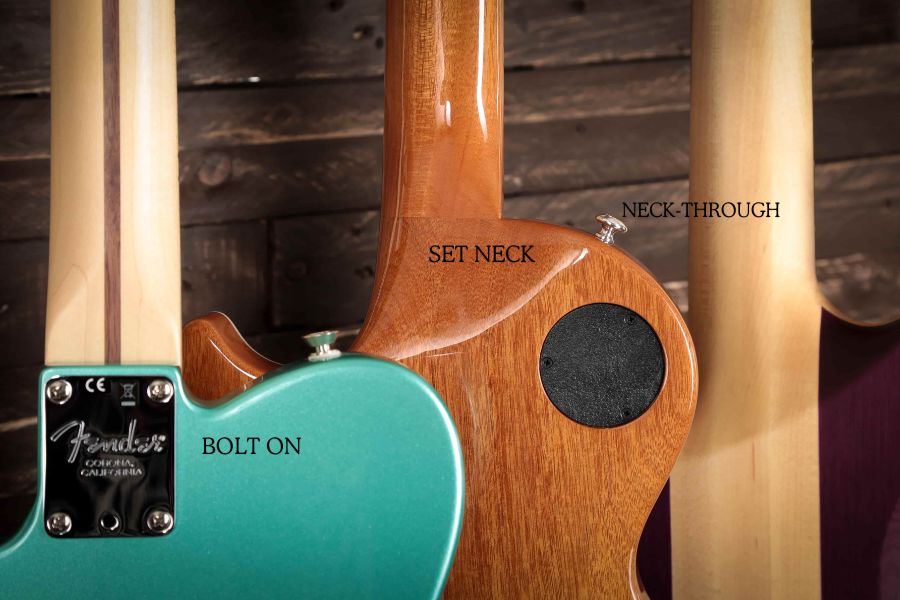
Neck Profile
Neck Profile refers to the cross-sectional shape of the neck. The neck’s shape, like C, U, or V, changes how it feels to play. For example, a “C” shape fits many styles, while a “V” might be better for thumb-over-the-neck playing.
Neck Attachment
Bolt-On
This is where the neck is attached to the body with bolts or screws. You see this a lot in Fender guitars. It makes the guitar sound snappy and makes fixing or swapping the neck easier. But, it might not sustain notes as long.
Set Neck
The neck is glued in place. Gibson guitars often use this style. It’s good for making notes last longer and sound warmer because the neck and body fit together really smoothly.
Neck-Through
The neck goes all the way through the guitar body,with “wings” glued on either side to form the body. This setup helps notes ring out for ages and keeps the guitar stable. Plus, it makes getting to high notes easier since there’s no big joint in the way.
Scale Length
Longer Scale Lengths: Think of Fender guitars, which have a 25.5″ scale. These guitars have strings that are a bit tighter. This makes the sound brighter and the guitar feel more snappy. It’s great for music that needs clear, sharp sounds.
Shorter Scale Lengths: Gibson guitars have a 24.75″ scale. This makes the strings easier to bend because they’re not as tight. The sound is warmer, perfect for rock and blues where you might want a smoother, more buttery tone.
Number Of Frets
The number of frets on an electric guitar changes how it plays and sounds. Here’s what you need to know:
More Frets = Closer Together: Adding frets can make them closer together. This might make playing a bit trickier for people with smaller hands.
- 22 Frets: Many guitars have 22 frets, enough for lots of music styles. It’s what you see on many classic guitars, like some by Fender.
- 24 Frets: With 24 frets, you get two full octaves per string. This is awesome for playing really high notes. Metal, shred, and progressive rock players love this because they often play fast and high.
Having 24 frets doesn’t make the guitar sound better or worse, but it changes the notes you can play. Also, more frets can mean the neck pickup is closer to the bridge, slightly changing the sound. A guitar with 22 frets might sound a bit warmer because of where the pickup sits.
Electronics and Wiring
All electronic parts—knobs, switches, and wiring—add up to make each electric guitar unique. They affect how it sounds, how easy it is to play, and what kind of music it’s best for. Knowing about these can help you pick the right guitar or tweak yours to fit your style better.
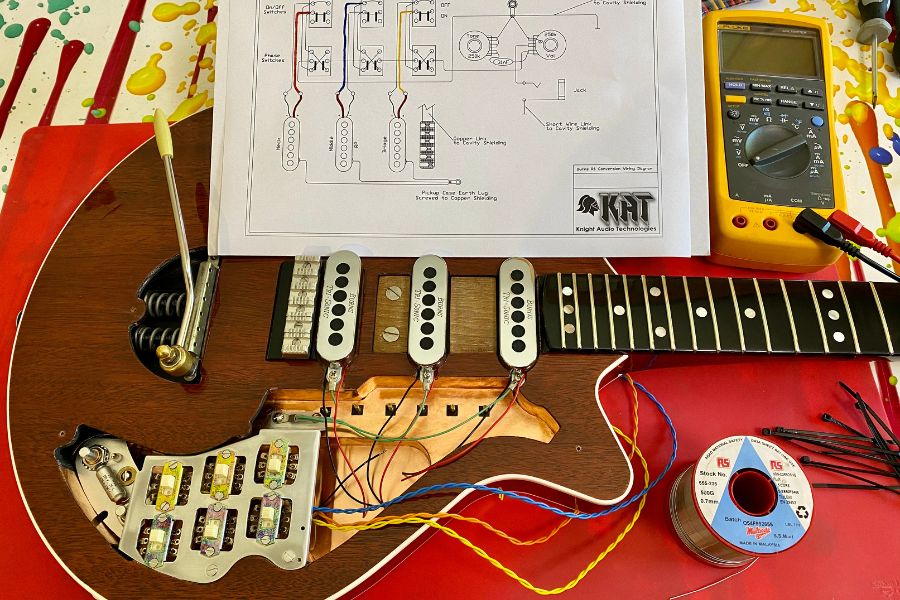
Volume and Tone Controls: Think of the Stratocaster. It usually has one knob for volume and two for tone. This setup lets you control how loud and what kind of sound you want. You can make your guitar sound bright for solos or warm for playing chords. It’s super handy for styles like blues and rock.
Pickup Selectors: The Gibson Les Paul has a 3-way switch for choosing pickups. You can pick the neck pickup for smooth sounds, the bridge pickup for sharp tones, or both together for something in the middle. That’s why it’s a top pick for playing rock, metal, and jazz.
Wiring Schemes: How your guitar’s pickups and knobs are wired can open up new sounds. Things like coil splitting let you switch a humbucker to a single-coil pickup. This means you can get a thick or bright sound from the same guitar. It’s great if you play lots of different music and don’t want to switch guitars.
Types of Electric Guitars: 5 Most Iconic Electric Guitars
Some electric guitars are legends. These guitars had features and styles that changed the world of music and led to a huge number of copies and versions. Even though there are new models and technologies, these classic guitars are still used as examples to help players imagine what sounds and looks like on an electric guitar.
Each well-known guitar has its own style. Their unique sounds, historical importance, and endorsement from other great artists that have cemented their places in music history. They come in a wide range of prices, from very expensive to less expensive.
Let’s talk about the five most famous electric guitars that have changed the instrument industry forever. Musicians of all levels often choose these names.
Fender Stratocaster
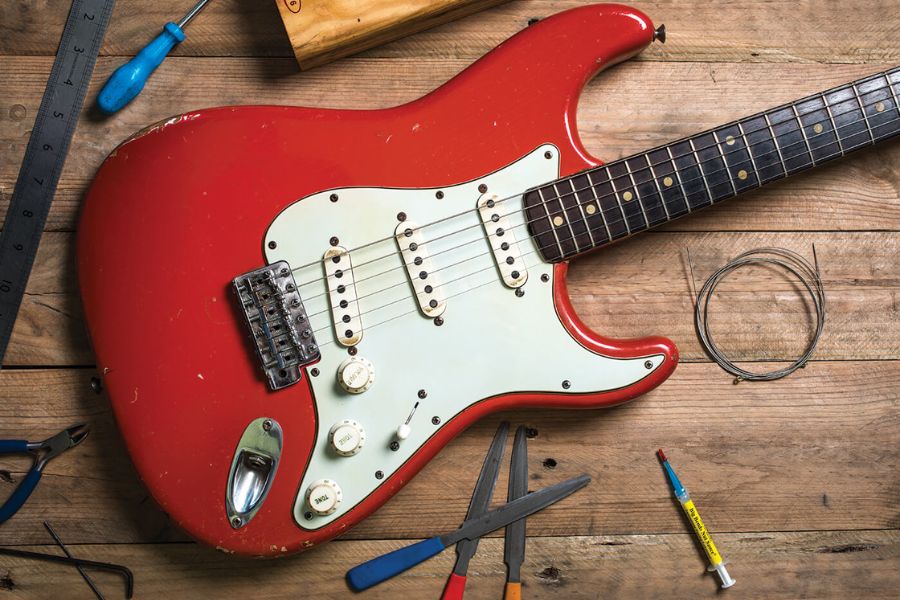
Now I’m going to talk about the legendary Fender Stratocaster, which came out in 1954. Because of its flexible sound and famous shaped body—it’s called the “comfort contour body” for a reason—this guitar is not only well-known, it’s also an important part of music history. As soon as you hold one, you feel ready for anything, from a short jam to a long show.
A guitar styled after the Strat has been made by almost every major guitar brand. Like Fender’s younger brother, Squier makes some great, low-cost copies. Next, Yamaha, Ibanez, and G&L (yes, that’s Leo Fender’s other business) are all making guitars that pay tribute to the Strat’s brilliant design.
Other than that, the Strat is made with a body made of alder or ash and a neck made of maple. This gives it a bright, punchy sound that just sings with sustain. It has three single-coil pickups and a 5-way selector switch, which lets you get an amazing range of sounds. It’s everything from smooth and shiny to hot and soft.
Its scale length is 25.5 inches, which adds to its clear sound and quick string reaction. The neck is shaped like a comfortable “C,” and the fretboard is usually made of maple or rosewood.
Do not forget the tremolo bridge; it really shows how you feel. It handles everything with ease, from dive bombs to soft vibrato.
Strats have been played by famous people like Jimi Hendrix, Eric Clapton, and David Gilmour, who have changed the sounds of rock, blues, and pop. When you hold a Strat, you don’t just hold a piece of music history; you hold every note, riff, and solo that made it famous.
Gibson Les Paul
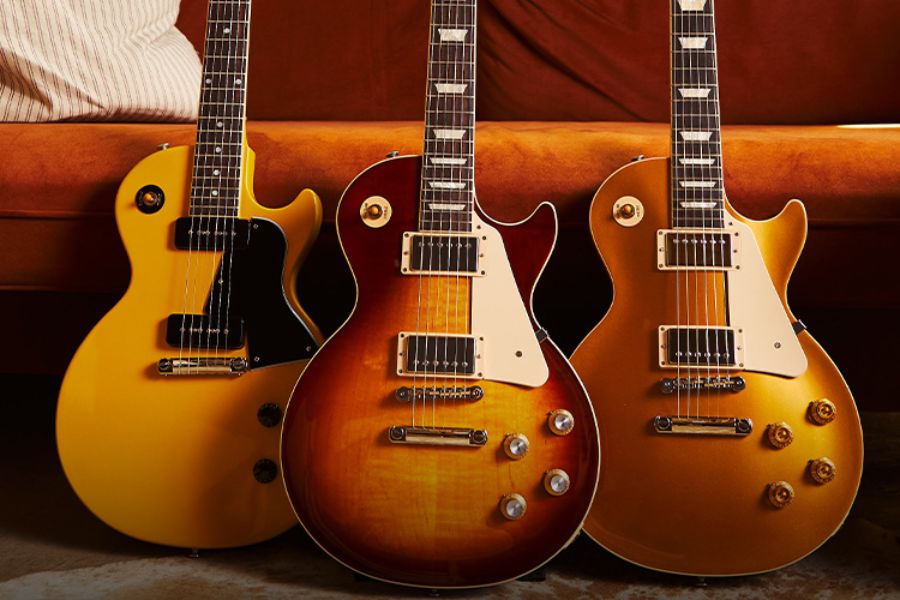
First sold by Gibson in 1952, the Les Paul is known for its thick, sustain-rich tone, provided by its set neck, mahogany body, and humbucking pickups.
For those of us watching our wallets, Epiphone, which is part of the Gibson family, offers more affordable Les Paul models. And it’s not just Epiphone; brands like ESP LTD, PRS (Paul Reed Smith), and Heritage Guitars have their takes on this iconic design, each adding their own twist while keeping that classic look.
What makes the Les Paul stand out? Well, it’s got this solid, single-cutaway body, usually crafted from mahogany with a maple top. This combo isn’t just for looks; it adds to the guitar’s heft and helps those notes ring out longer.
Speaking of tone, the mix of mahogany and maple gives the Les Paul its signature warmth and sustain. It’s like each note just hangs in the air, full of richness. And with two humbucker pickups, you get a sound that’s thick and powerful, cutting through noise and buzz like a knife through butter.
The Les Paul isn’t just about sound; it’s about feel, too. With a scale length of 24.75 inches, bending strings feels like a breeze, and the warmth in the tone? Chef’s kiss. The neck is chunky, in a good way, giving you something substantial to hold onto, and the rosewood fingerboard just adds to the experience.
And let’s not forget the hardware. Whether it’s got a fixed bridge or a Tune-o-matic bridge with a stopbar tailpiece, this guitar stays in tune and sustains for days.
Icons like Jimmy Page, Slash, and the man Les Paul himself have made magic with this guitar. It’s more than an instrument; it’s a piece of rock and roll history.
Fender Telecaster
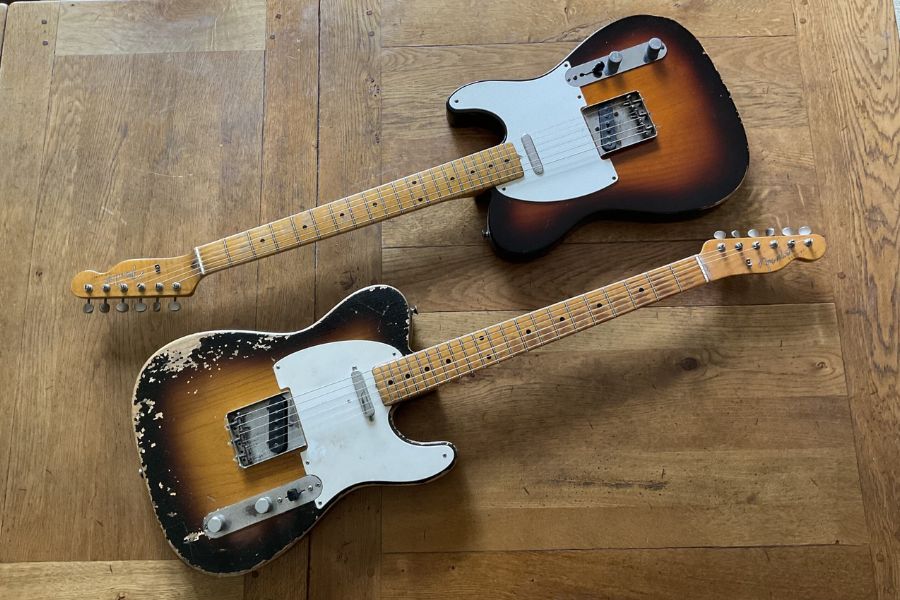
The Telecaster, first hitting the scene in 1950 as the Broadcaster by Fender, quickly became a staple for its no-frills design and crisp sound. It’s the go-to guitar for everything from country twang to rock’s roar.
But if you are looking for a Tele without breaking the bank, Squier’s got you covered with affordable models. And it’s not just Squier; brands like G&L and Peavey offer their takes, capturing that iconic Tele vibe.
The Tele’s magic starts with its straightforward, single-cutaway body. It’s easy to play and light to hold. Made from either ash or alder, it punches out a bright, edgy tone that stands out in any mix.
It rocks two single-coil pickups, dialing in everything from biting blues to mellow warmth. Like the Stratocaster, it sports a 25.5-inch scale length, giving it a lively feel and precise sound.
The neck is a comfy “C” shape paired with a slick maple fingerboard for quick moves up and down the frets. Its fixed bridge keeps things steady, ensuring each note hangs just right.
Legends like Bruce Springsteen and Keith Richards have wielded the Telecaster, embedding it deep in the roots of rock, country, and blues.
Gibson SG
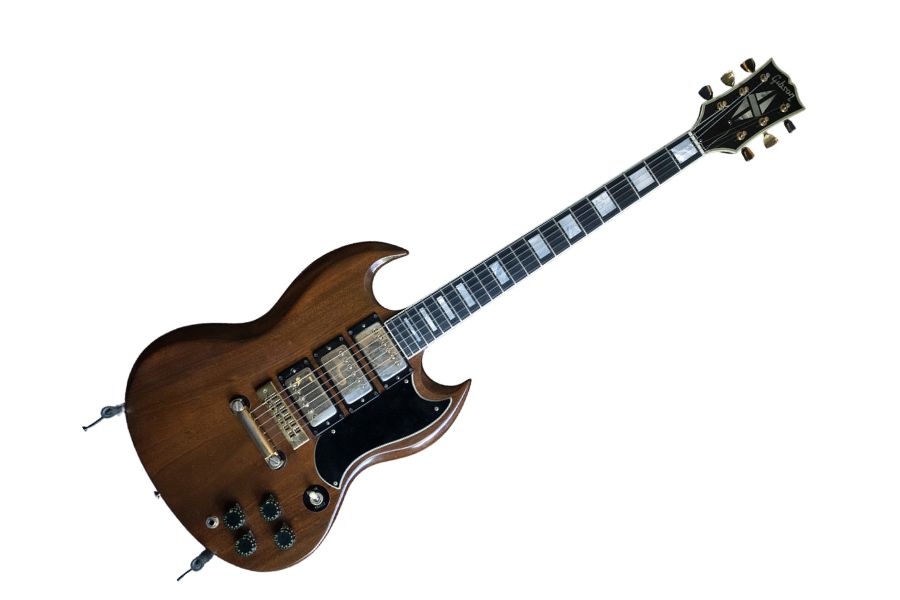
The SG, short for “Solid Guitar,” broke onto the scene in 1961. Originally part of the Les Paul lineup, it quickly became its own rock icon. It’s loved for its light feel, easy-to-reach frets thanks to those double cutaways, and a neck that lets you play fast.
Epiphone, under Gibson’s wing, offers its take on the SG, making this classic more accessible. Brands like Ibanez and ESP LTD also have their versions, capturing the SG’s bold spirit.
Its body is sleek and thin, with double cutaways. The SG’s mostly made from mahogany, so it has given a deep, resonant sound and great sustain.
You will love the SG’s slim neck and smooth rosewood fingerboard for quick and comfy playing. It comes with a stable fixed bridge, keeping your tuning tight and your sustain long.
With two humbucking pickups, the SG packs a punch. Its sound is warm yet powerful. The 24.75-inch scale length, a Gibson standard, makes strings easier to bend.
Icons like Angus Young, Tony Iommi, and Frank Zappa have made the SG legendary in the rock world.
Gibson ES-335
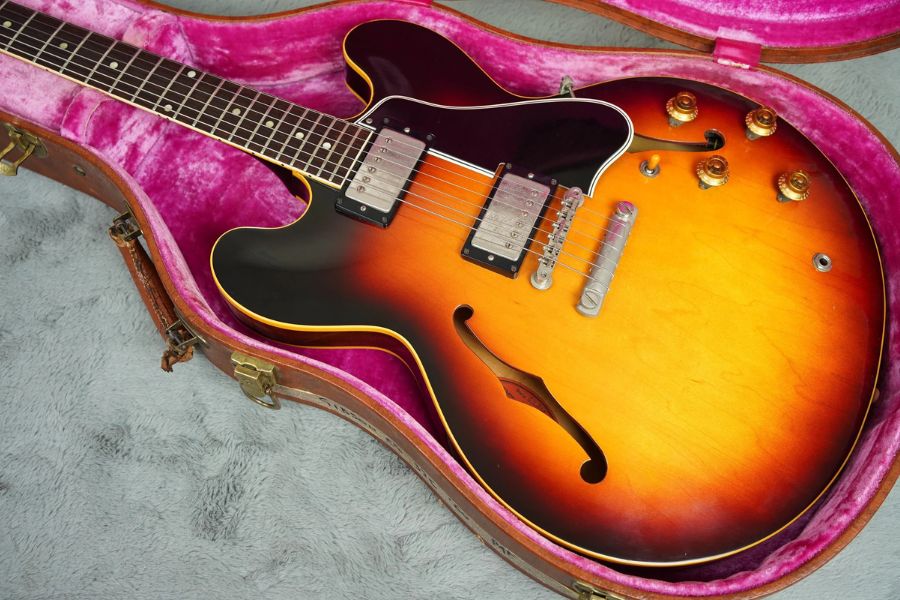
Let me present you to the Gibson ES-335. It was a revolutionary guitar when it came out in 1958. For some reason, it sounds great because it’s a mix of a solid-body and a hollow-body guitar. Thought about getting an ES-335 but need something a little easier on the wallet? Epiphone has some great options for you. Also, Ibanez with its Artcore line and Gretsch are both in the game with guitars that have the same cool vibe as Epiphone.
What does the ES-335 do that’s different? Well, it was the first with a semi-hollow body, which combined the best of both worlds: the deep, rich sounds of a hollow body with the control over sustain and feedback that comes from a solid body. In 1958, this was a huge step forward.
The gorgeous thing about the ES-335 is how flexible it is. The tone of this guitar can be changed to fit your tastes in jazz, blues, rock, or even country. That adaptability is what makes it stand out.
A thick wood center block is at the heart of its design. It reduces feedback and increases sustain, making it great for turning up the volume or playing different styles.
Icons like B.B. King, Eric Clapton, and Larry Carlton have all done amazing things with the ES-335, making it even more famous.
Conclusion
In conclusion, the huge variety of electric guitars makes modern music special in its looks, sounds, and features. Each model was carefully made so that players can get lost in their musical journeys and share their musical ideas.
From the classic curves and deep, resonant tones of a Les Paul to the sharp, unmistakable twang of a Telecaster to the versatile, adaptive electronics of a Jaguar.









